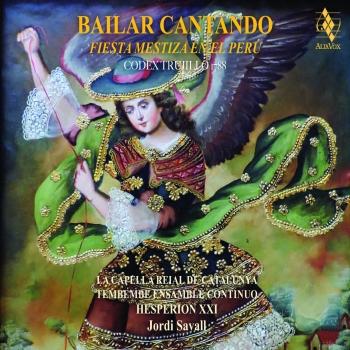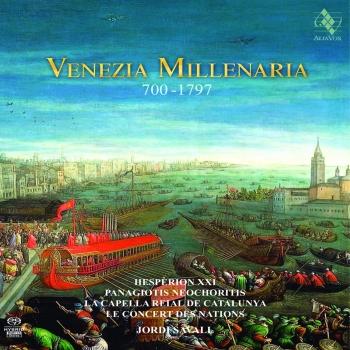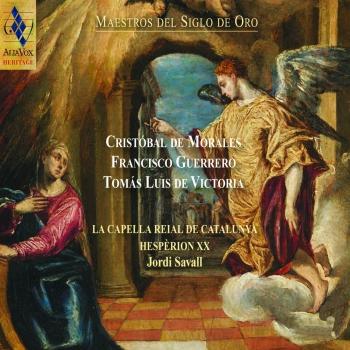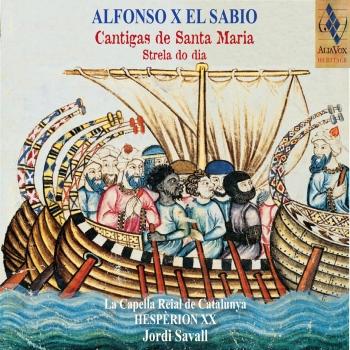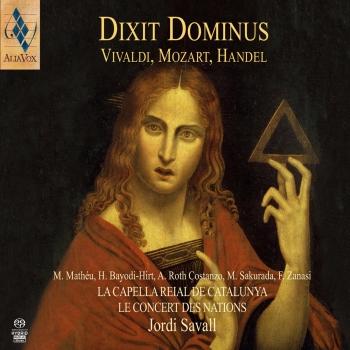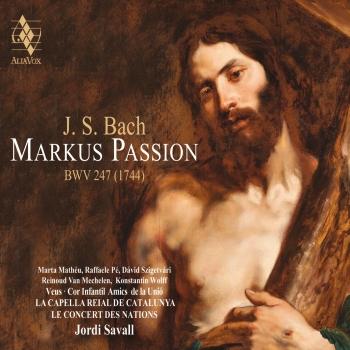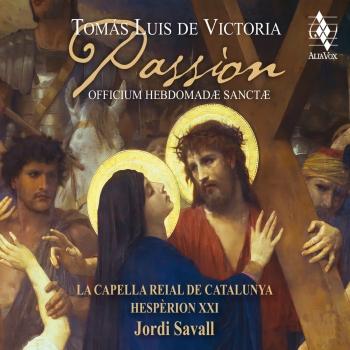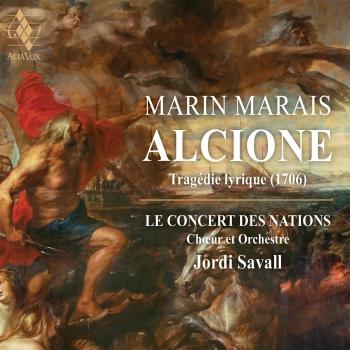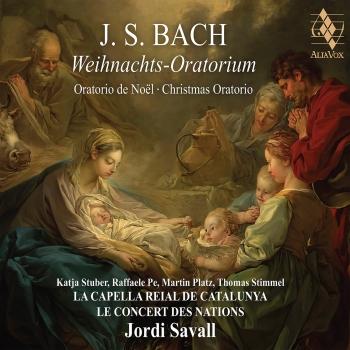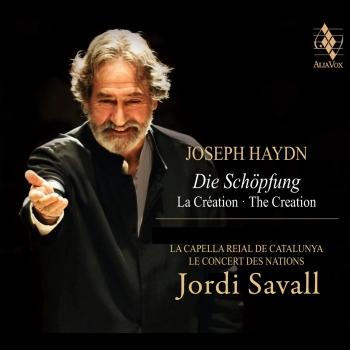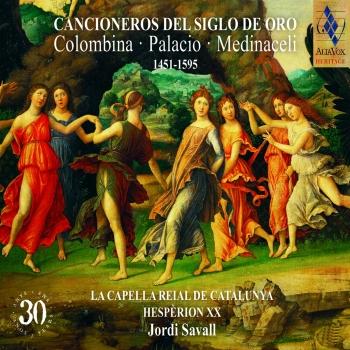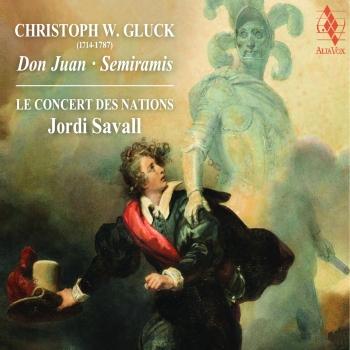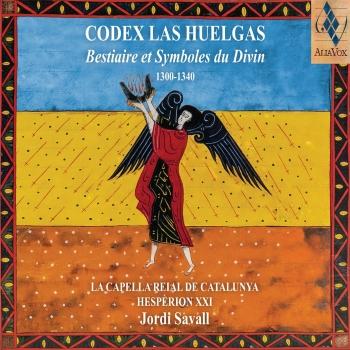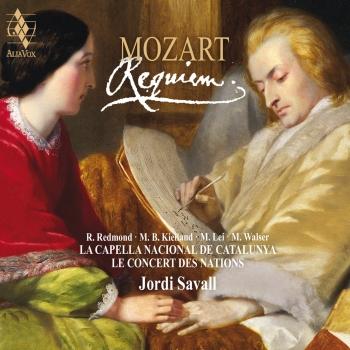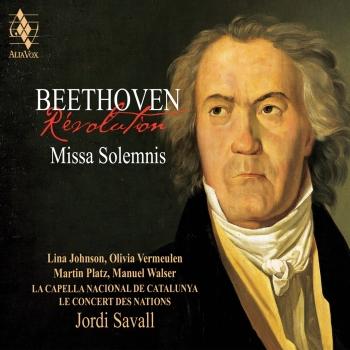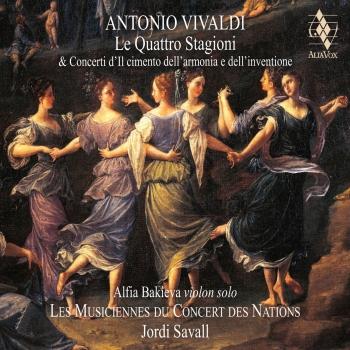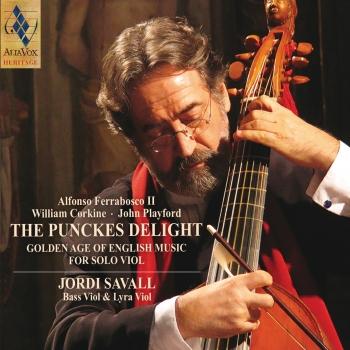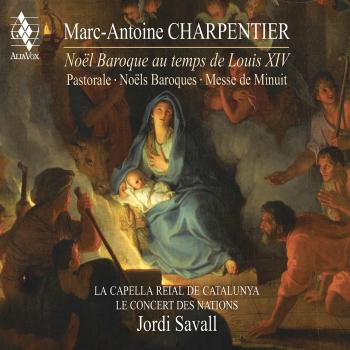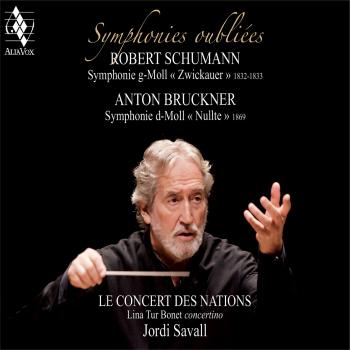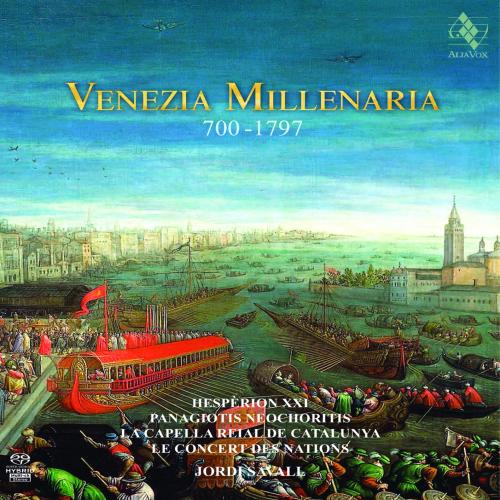
Venezia Millenaria Jordi Savall
Album info
Album-Release:
2017
HRA-Release:
08.01.2019
Album including Album cover
- Traditional:
- 1 Fanfare (Instrumental d’après une mélodie du siècle VIII) 01:11
- Ioannis Damaskinos:
- 2 Alléluia (Choral byzantin) 05:26
- Anonymous:
- 3 Halatzoglou kratema (Instrumental byzantin) 01:45
- Traditional: Chanson de Croisade:
- 4 Chanson de Croisade: Pax in nomine Domini – Marcabru (1100-1150) 02:55
- Anonymous:
- 5 Danse de l’âme (Afrique du Nord) [Instrumental] [Tradition Berbère] 02:44
- Traditional:
- 6 Hymne pour les services des Matins 06:50
- 7 Chanson & Danse arménienne (XIIIe siècle) 02:35
- Conductus:
- 8 Conductus: O totus Asie Gloria, Regis Alexandria Filia (XIIIe siècle) 02:19
- Anonymous: Istampitta:
- 9 Istampitta: Saltarello (mss. XIVe siècle) 02:25
- Ioannis Damaskinos:
- 10 Pásan tin elpida mu 04:35
- Anonymous:
- 11 Chiave, chiave (Instrumental) [Début du XVe siècle] 01:20
- 12 Adoramus te (Chansonnier du XVe siècle) 02:57
- Hirmos Calophonique:
- 13 Hirmos Calophonique: Tin Déisin mu (XVe siècle) 05:26
- Traditional:
- 14 Marche Ottomane Nikriz peşrev – Ali Ufki Bey 02:08
- Guillaume Dufay (1397 - 1474):
- 15 Lamentio Sanctae Matris Ecclesiae Constantinopolitanae 07:42
- Clément Janequin (1485 - 1558): La Guerre:
- 16 La Guerre: La Bataille de Marignan 07:21
- Traditional: Cantique des Cantiques (3,1-4):
- 17 Cantique des Cantiques (3,1-4): Qamti be-Ishon Layla 03:20
- Adrian Willaert (1490 - 1562): Villanesca alla napolitana:
- 18 Villanesca alla napolitana: Vecchie letrose 02:46
- Dimitrie Cantemir (1673 - 1723):
- 19 Der makām-ı Uzzäl Sakîl (Instrumental ottoman) 04:21
- Joan Brudieu (1520 - 1591): Madrigal:
- 20 Madrigal: Oíd, oíd... [...las buenas nuevas de Lepanto] 06:02
- Claude Goudimel (1510 - 1572):
- 21 Psaumes de David. Ficht wider meine Anfechter (Psaume 35) 02:13
- Ioannis Kladas (14-15th Cent.):
- 22 Géfsasthe ke idete 04:30
- Traditional:
- 23 Sousta (Instrumental) [Danse de Chypre] 01:58
- Andrea Gabrieli (1533 - 1585):
- 24 Ricercar VII 02:35
- Michael Chatziathanasiou:
- 25 Hymne de la Sainte Eucharistie (En slave) 02:22
- Anonymous:
- 26 Laïla Djân (Instrumental) [Danse Perse] 02:34
- Salomone Rossi (1570 - 1630): Psaume 137, (1-6):
- 27 Psaume 137, (1-6): ’Al nàhärót bavél 03:34
- Claudio Monteverdi (1567 - 1643):
- 28 Il combattimento di Tancredi e Clorinda, SV 153 16:51
- Johann Rosenmüller (1619 - 1684):
- 29 Sinfonia Seconda 04:14
- Tanburi Angeli:
- 30 Der Makām-i-Rehavi Çember-i-Koca (Marche ottomane) 03:05
- Antonio Vivaldi (1678 - 1741): La Senna festeggiante, RV 693:
- 31 La Senna festeggiante, RV 693: Di queste selve venite, o Numi 04:12
- Jordi Savall (b. 1971):
- 32 Alla turca (Allegretto) [D’après la Sonate No. 11 en La Majeur, K. 331 de Mozart] 04:09
- Anonymous:
- 33 Deo gratias (Hymne Orthodoxe Russe du XVIè siècle) 07:26
- Traditional:
- 34 Chanson Constitutionnelle Nous sommes tous égaux 02:40
- Johann Adolf Hasse (1699 - 1783): Canzonette veneziane da battello. Raccolta di gondoliere:
- 35 Canzonette veneziane da battello. Raccolta di gondoliere: Per quel bel viso 03:43
- 36 Canzonette veneziane da battello. Raccolta di gondoliere: Mia cara Anzoletta 02:50
- Luigi Bordèse (1815 - 1886):
- 37 La Sainte Ligue (La nuit est sombre) [D'après les Symphonies No. 5 et No. 7 de Beethoven] 09:41
Info for Venezia Millenaria
For approximately a thousand years, from 770 to 1797, the city of Venice played a pre-eminent role in the Mediterranean and in the history of the world. Situated in a lagoon fed by two rivers where a number of small, precarious settlements had grown up along the coast, Venice was founded by the Byzantines, who made it a crossroads between the East and the West. This essentially aquatic city, with its network of canals, attracted merchants of many different origins who worked towards a common goal: to create a thriving hub of business, exchange and interests. The city gradually developed a trade in goods from the East (spices, silks, precious metals, luxury items) to the West, which were exchanged for other goods and commodities (such as salt and timber) bound for the East.
By setting up a “Republic” in which the system of government by an oligarchy led and represented by an elected life Doge, Venice gradually gained independence from the Byzantines, eventually becoming more of a trading partner than a vassal.
Quite rapidly over the course of the millennium, this legendary city grew rich, independent and powerful, thanks to the development of its fleet. Having resisted Charlemagne, it successfully competed with Rome to emerge as the leading economic power in the Mediterranean Basin, which made possible the technical, scientific and cultural progress so evident in Venetian architecture, painting, literature and music, among others.
From the beginning and, especially, towards the end of the 15th century, Venice benefited from two great advantages: first, it enjoyed total freedom to print books, as it was not subject to the dictates of the Vatican and the Inquisition; and second, it was the Gateway to the Orient, and home to people from around the world – Byzantines, Italians, Arabs, Jews, Slavs, Armenians and Turks. All of this goes to explain the extraordinary development of its publishing industry. In an age marked by so much religious conflict, it is remarkable that Venice produced the first printed editions of the Koran and the Talmud, and the first Bible in the Italian vulgate following the Protestant Reformation, as well as the first books to come out of the German Reformation. The fact that it was a city of immigration also accounts for the fact that books were published there in all languages: thus, we see the first printed books in Greek, Armenian, and in the Cyrillic alphabet… And more than half of all European books were printed in Venice. It was, moreover, the city that invented the bestseller and the paperback, as well as printing the earliest editions of erotic books, cookery books and medical texts. Venice also devised the first rudimentary systems of copyright and what we now call marketing and business techniques.
It was also in this multicultural city that music printing began at the end of the 15th century. Although we now symbolically date the birth of music printing to 1501, with the publication of Ottaviano Petrucci’s Harmonice musices Odhecaton (One hundred songs of harmonic music), in fact, as early as 1480, Ottaviano Scotto (c.1440-1498) a native of Monza in Lombardy, printed among other things some splendid missals in red and black lettering. He was the founder of a dynasty of typographers who were to dominate music printing in Venice throughout the 16th century. Although Ottaviano Petrucci’s book of music published in 1501 was not the first to be printed using movable type, it was the first work devoted entirely to music, rather than containing only brief fragments inserted into a liturgical or poetic text. For more than three centuries, the Venetian printing industry was to play a key part in the increasingly influential role of both music and Italian and European music theory, an influence that would continue to spread across borders and through the centuries.
Finally, it was also thanks to trade and therefore its contacts all round the Mediterranean as a result of setting up trading-posts on the islands and along the coast to exchange goods, but also welcoming people of all origins, that Venice received the various influences of the Eastern Christian, Latin and Orthodox worlds, as well as those from the Ottoman, Jewish, Armenian and Muslim cultures.
These are the influences that we set out to evoke through music as we trace the landmark events over a thousand years of the city’s amazing history. The unique history of a distinctive city, fashioned by men who had the vision to create and preserve the prosperity and freedom of their Republic for more than a thousand years thanks to their courage, know-how, thirst for adventure and dialogue, and, above all, their love of the arts and beauty.
We shall offer insight into those influences as we explore the varying sound landscapes of the Adriatic and the Mediterranean, depending on the city and region, as well as their neighbouring countries. With the splendid singers of the Orthodox/Byzantine ensemble under the direction of the outstanding Orthodox chanter Panagiotis Neochoritis, our guest musicians from Greece, Turkey, Morocco, Armenia, and the soloists of La Capella Reial de Catalunya, Hespèrion XXI and Le Concert des Nations, we present a selection of sacred and secular music from the ancient Orthodox traditions of Byzantium, Crusader songs, music from Istanbul and the Ottoman Empire, Greece, Turkey and, of course, Italy. They were to enhance and influence the wonderful music that Byzantium and Venice bequeathed to the history of European music. Composers such as Guillaume Dufay, Clément Janequin, Adrian Willaert, Joan Brudieu, Claude Goudimel, Ambrosius Lobwasser, Giovanni Gabrieli, Claudio Monteverdi, Antonio Vivaldi, Johann Adolph Hasse and many others, including Mozart and Beethoven, proclaimed and evoked in the Europe of their age and up to the present time the grandeur of an exceptional city which for so long reigned supreme.
In 1797 the French troops of Napoleon Bonaparte occupied the Terra Firma, thus hastening the fall of the Republic of Venice. To evoke the end of this thousand years of history, which was precipitated by the influence of the French Revolution and Napoleon’s imperial ambitions, we have chosen an unusual and moving piece composed some years later, the revolutionary hymn “La Sainte Ligue” La nuit est sombre by Luigi Bordèse (1815-1886), sung to a text by Adolphe Joly adapted for 4-voice male choir with organ (or piano) set to music by Ludwig van Beethoven the Allegretto from his Seventh Symphony and the closing Allegro from his Fifth Symphony. Our musical version adds to these 4 sung parts the essential instrumental texture found in Beethoven’s original score, the difference being that it is performed here by the varied line-up used in the second part of the programme.
Although the Republic of Venice ceased to exist in 1797, La Serenissima’s Oriental dream did not, indeed, as Olivier Lexa points out, it continued to inspire a large number of artists and intellectuals, including John Ruskin, who wrote that the Venetians deserved special mention because they were “the only European people who appear to have sympathised to the full with the great instinct of the Eastern races.” At the dawn of the 20th century, the artist and designer Marià Fortuny y Madrazo, the son of the famous Catalan painter Marià Fortuny i Marsal, paid tribute to the Oriental history of Venice in his celebrated designs for lamps and fabrics.
After its annexation to Austria under the Treaty of Campo Formio of 1797, which put an end to the war between France and Austria, Venice finally became part of the kingdom of Italy in 1866. Together with Rome, it became one of Italy’s “eternal” cities, and remains to this day one of the loveliest jewels in the nation’s crown.
"Despite its hefty, hardbound, 300-plus-page book and attendant top price, Jordi Savall's Venezia Millenaria has appeared on commercial sales charts. It's easy to see why: this is one of Savall's most ambitious concepts, covering the promised millennium of the history of the city of Venice, Italy, plus a bit more as a bonus, taking you up to the end of Venice's independence. The book contains enough information that it could serve as the basis for a little travelers' course, but there's also a case to be made for just listening and letting a thousand years of music wash over you. Venice was a diverse city where numerous languages could be heard on the street, and Savall represents the various musical cultures that made up Venice's mosaic -- not only Turks and Byzantines, but Greeks, Jews, and even Cypriots. All this while unearthing unusual works that depict major events of the time, including the big ones (the fall of Constantinople) as well as those that you may not have read about (sample the marvelous Clément Janequin battle chanson depicting the 1515 Battle of Marignan). Savall brings aboard Eastern musicians to complement his Hesperion XXI and Concert de Nations choir. The whole production would be worth the money even for the texted Beethoven symphony movements at the end, and there is so much more. An impressive achievement even by Savall's standards." (James Manheim, AMG)
Panagiotis Neochoritis
Hesperion XXI
La Capella Reial de Catalunya
Le Concert des Nations
Jordi Savall, direction
Jordi Savall
Born on August 1, 1941, in Igualada, near Barcelona, Spain; married Montserrat Figueras (a musician), 1968. Education: Barcelona Conservatory, diploma; Schola Cantorum Basiliensis, diploma, 1970. Addresses: Record company---Naive Classique, 148 rue du Faubourg Possinière, 75010 Paris, France.
The works performed by Catalan gambist and conductor Jordi Savall span several centuries---from the music of Alfonso el Sabio, king of Castile and Léon, to the works of J. S. Bach---bringing to life the splendor and passion of bygone eras. A performance by Savall is more than a musical experience: the extraordinary power and beauty of his playing magically removes the listener from the flux of time, creating a space in which such obstacles to enjoyment as historical distance, stylistic peculiarities, and idiomatic enigmas simply disappear. For example, historical periods, including the Baroque, have often been described as "distant." Indeed, the physical and mental universe of seventeenth-century France may seem distant to a person living in the twenty-first century. But that distance vanishes when Savall plays the music of the great French master of the bass viol, Marin Marais.
First of all, Savall's main instrument is the viola da gamba, or bass viol (he also plays the smaller viols), not as a quaint relic that needs some special justification or antiquarian explanation. True, in the late 1700s, the viola da gamba---which is not a different kind of cello, but a member of the viol family, a distinct group of instruments of varying sizes---was supplanted by the cello, as the latter instrument, with its potential for virtuosity, satisfied the requirements of changing musical styles. However, to Savall, his instrument is irreplaceable. In fact, according to Savall, the viola da gamba has a particular sonic richness that the more "modern" cello lacks. As Savall explained to Chris Pasles of the Los Angeles Times, the "viola da gamba is totally different from a cello. It's closer to the lute---a lute with a bow, in fact. With six strings, frets like a guitar, a softer sound, it's more rich in different colors." Instead of merely reproducing a particular musical composition, Savall captures and expresses the timeless humanity of the music, illuminating the particular composition as a universally comprehensible document of the human experience. A case in point is Savall's mesmerizing performance of Marais's musical description, found in Book V of his Pièces de viole, of his gallstone operation. Written under the influence of François Couperin's character pieces, this extraordinary composition, especially in Savall's version, remains one of the most suggestively dramatic works of Baroque music.
Born in 1941, near the Catalan city of Barcelona, Savall began his musical education at the age of six. After graduation from the Barcelona Conservatory, where he studied the cello, Savall went to Basel, Switzerland, where he studied the viola da gamba with August Wenzinger at the Schola Cantorum Basiliensis, receiving a diploma in 1970. His other teachers included Wieland Kuijken, in Brussels. In 1973 Savall took over Wenzinger's post at the Schola Cantorum. By the early 1970s, Savall was already considered one the greatest viola da gamba players. In addition, he worked hard to enrich his instrument's repertoire, rescuing many works from oblivion and performing and recording numerous forgotten compositions. Savall thus exemplified, as he still does, the learned performer, who constantly studies the vast field of old music, bringing many neglected compositions to light. Among these lesser-known compositions are works by Marais, whose rich and fascinating oeuvre includes more than 500 pieces for viola da gamba and keyboard accompaniment, assembled in five books of his Pièces de viole.
In 1974 Savall and his wife, soprano Montserrat Figueras, founded Hespèrion XX---later, in the twenty-first century, known as Hespèrion XXI---an international ensemble that has gained great acclaim for its extraordinary performances of music from the Middle Ages to the Baroque. In 1987, returning to his native city after his extensive sojourn in foreign lands, Savall formed the Capella Reial de Catalunya, a vocal group that, under his direction, has performed and recorded music by Tomáa Luis de Victoria, Francisco Guerrero, and Claudio Monteverdi.
In 1989, further expanding his repertoire and musical activities, Savall founded the Concert des Nations, an ensemble consisting of younger musicians from Spain and Latin America. Under Savall's direction, this orchestra, which plays on period instruments, has recorded a variety of works from the Baroque and Classical periods.
Savall's career received a tremendous boost when film director Alain Corneau asked him to play on the soundtrack for Tous les matins du monde, his 1992 film about Marais and his teacher, Sainte-Colombe. Based on Pascal Quignard's admirable 1991 novel--available in English as All the World's Mornings--which imagines the life of the mysterious Sieur de Sainte-Colombe, the film is a spell-binding portrait of seventeenth-century France with the music, performed by Savall, providing a foundation for the narrative. Savall himself indirectly inspired Quignard's novel: it was a 1976 recording by Savall that introduced the writer to Sainte-Colombe's music. The music that Savall performs on the soundtrack is mostly by Marais and Sainte-Colombe, though it also includes a segment of François Couperin's deeply spiritual Leçons des ténèbres. Savall is inspired in his performance of the heartrending Tombeau les regrets, which, in Quignard's imagination, Sainte-Colombe played to conjure up the spirit of his deceased wife. In Savall's hands, this music, which appears as a leitmotif throughout the film, graces the rich tapestry of the film as a mysterious aura.
In 1988 the French Ministry of Culture awarded Savall the title of Officier de l'Ordre des Arts et Lettres. His recordings, numbering more than one hundred, have received many awards, including the Double Disc of Gold and the Diapason d'Or. In 1997 Savall's recording company, Astrée, founded a separate label, Fontalis, for his recordings. The following year, Savall started his own label, Alia Vox, which later reissued many of his earlier recordings at an affordable price. Savall's remarkable career is more than a personal triumph: thanks to his superb musicianship, the viola de gamba has emerged from the shadows of the past, becoming the instrument of choice for many younger performers. For such performers, the rich repertoire of the Renaissance and Baroque offers not only infinite artistic challenges and possibilities but the opportunity to abolish the somewhat artificial barrier separating "early" music from the rest of the musical tradition. (Zoran Minderovic)
This album contains no booklet.















